
The Life, Death And Rebirth Of Curlew Lake
Yellow perch have officially taken over Curlew Lake.
OK, so that’s not exactly breaking news and, yes, there still are and likely always will be rainbow trout to catch at the famed Northcentral Washington fishery.
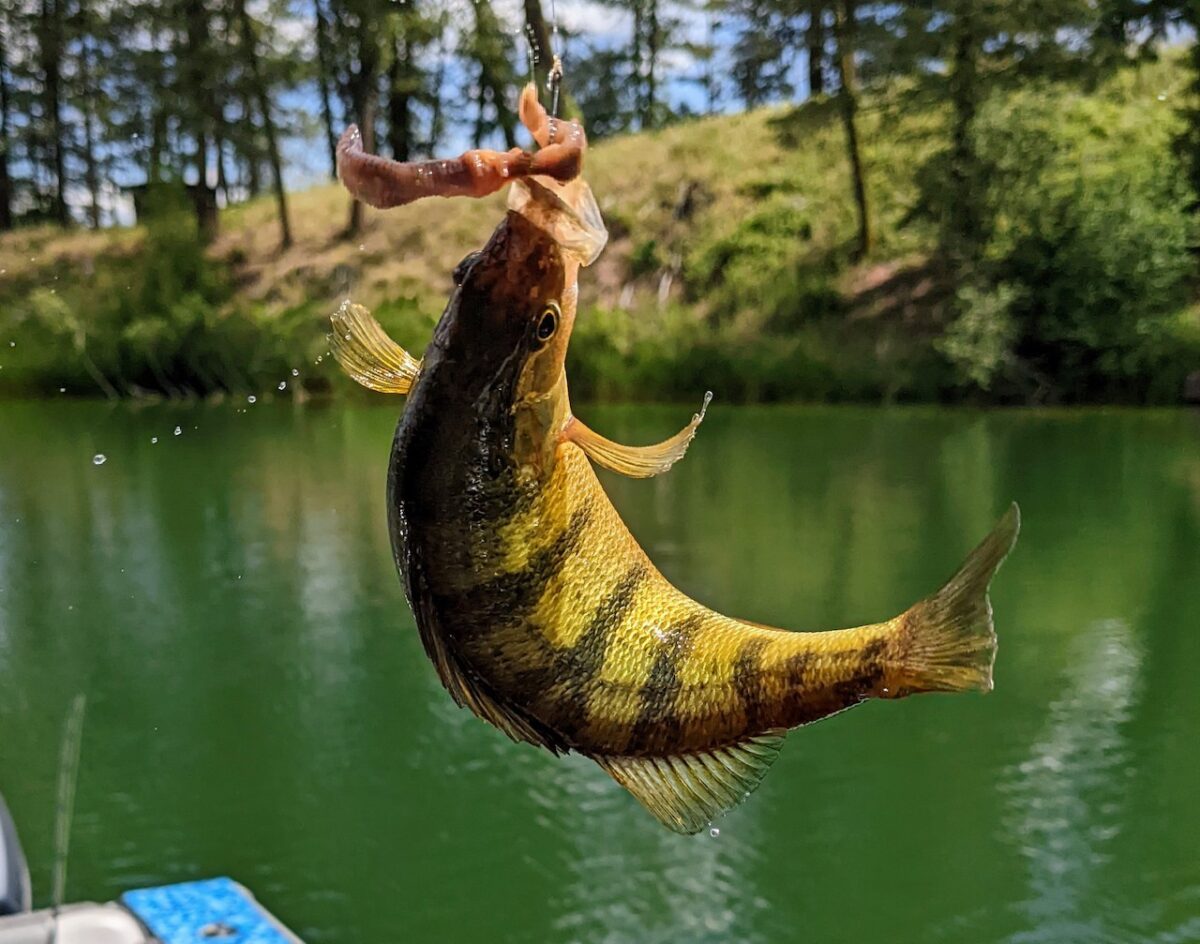
But a dozen years or so after a bucket biologist or two illegally tipped the barred, spinyrayed nonnative species into the lake, perch are now by far the most harvested and popular fish here and have effectively overthrown Curlew’s state management strategy.
A recently released report by WDFW on a nine-month creel survey performed at the lake fleshes out how far the filet table has turned.
Some 81,147 perch were kept between May 2021 and February 2022, but only 9,448 rainbows were stringered over the same timeframe. While anglers likely also released many undersized trout, the sampling showed that only 5.1 percent of the lake’s large stocking of fingerlings and put-grow-and-take fish were turning up in the creel, a “very low” rate of return.
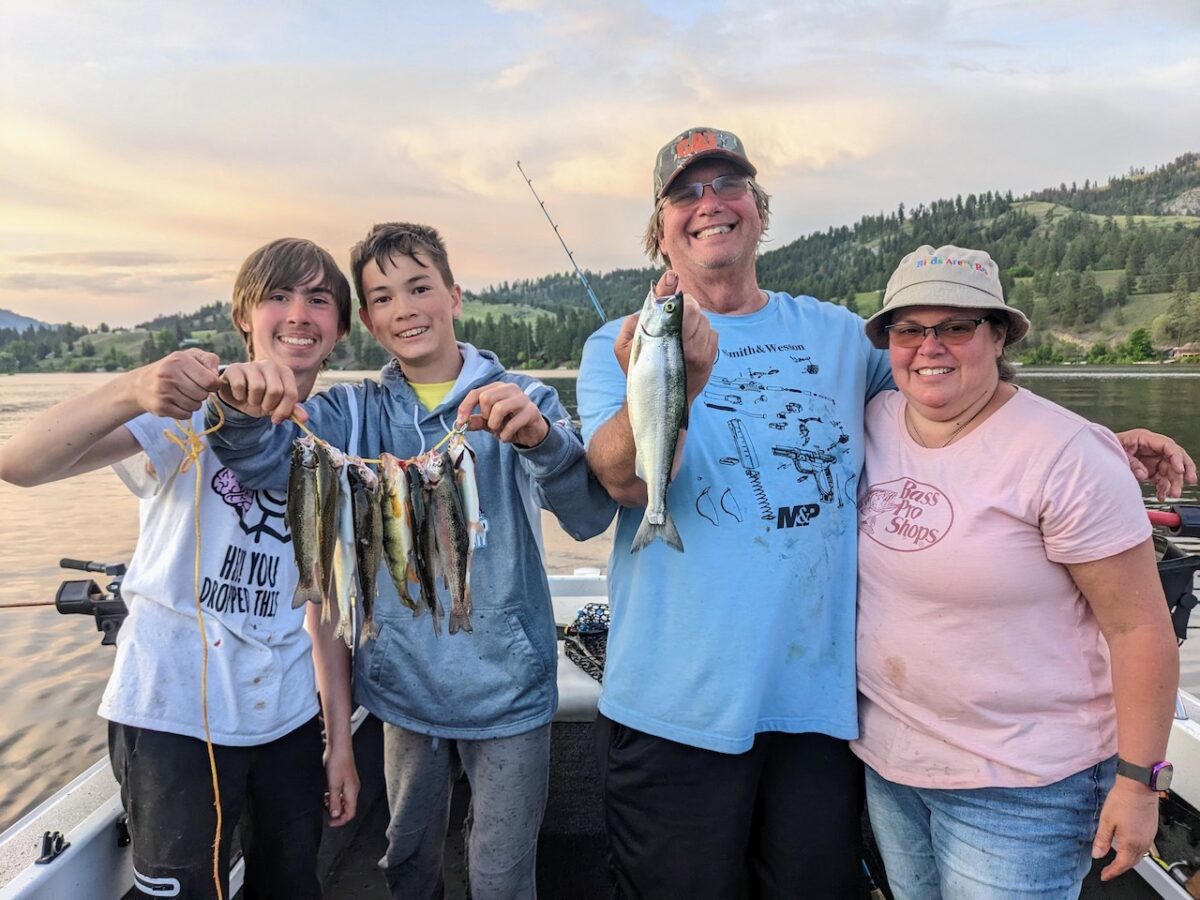
The numbers aren’t unexpected but they were still sobering to state managers. Rainbow fishing represented “a much smaller component of overall effort, catch, and harvest than was expected, based on the popularity of the trout fishery as recently as 2011,” WDFW reported.
And they also help explain why the agency has quit managing Curlew as a trout emphasis water (it also has bass and tiger musky) and instead will now try to maintain the relatively high-quality perch fishery alongside much more limited rainbow releases.
WDFW staffers have mixed feelings about all that.
On the one hand, you can still sense resentment about what happened on their watch to what once was one of Washington’s marquee trout destinations. The lake attracted generations of anglers and their families from far and wide to troll, still fish, cast from docks or the bank, or drill holes in the ice for meaty and well-stocked rainbows practically year-round, all while staying at the state park, local resorts, or cabins or second homes, and pumping dollars into the local economy.
“I worked on a study in that lake and over the several-year period I was spending time there, I spoke to a lot of anglers. Every single adult I spoke to was there because their parents took them to Curlew when they were children and now they are taking their children there to enjoy a family fishing experience. There are three private resorts and a state park that rely on the trout fishery to attract customers.”
–Retired WDFW Warmwater Manager Bruce Bolding, speaking in June 2012, not long after the discovery of perch at Curlew
The trout as well as largemouth fisheries were regularly written up in the pages of Washington Fishing & Hunting News, a review of my archives shows.

On the other hand, and by sheer utter luck, Curlew has essentially instantly shot into the ranks of the Northwest’s premier perch fisheries. It doesn’t have the consistent number of jumbos that Idaho’s Lake Cascade does, but if you’re looking for lots of 9- to 11-inchers with a few larger ones from time to time, pack up your nightcrawlers, curltails and tube jigs, Swedish Pimples and fishfinders.
To be clear, there’s no going back to The Way Things Once Were.
“Had there been viable management options to maintain the historical trout fishery in Curlew Lake, we would have considered them,” says Bill Baker, WDFW’s district fish biologist for Washington’s northeastern corner and who wrote that creel report with agency warmwater bios Danny Garrett and Kent Mayer. “But with a perennial outlet to the Kettle River and the large size and volume of the lake, it was apparent that management options were limited and that we had to make the best of the situation.”
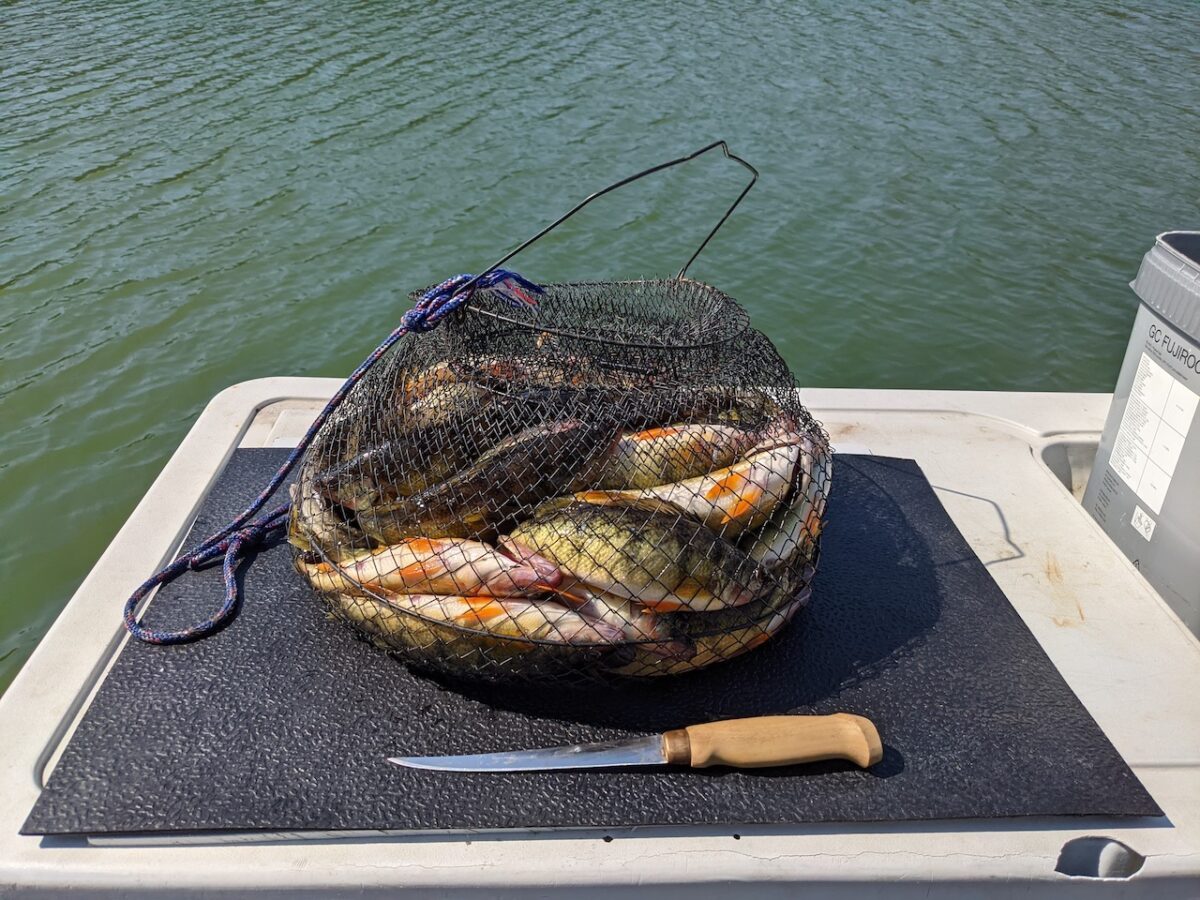
BAKER WAS THE ONE WHO DISCOVERED perch had been dumped into the 861-acre Ferry County lake one spring in the early 2010s when a single 5- to 6-inch fish turned up in his gillnet during an annual trout stocking evaluation. Subsequent years showed multiple year classes were growing and by 2019, the number caught during sampling had jumped 500-fold, according to the creel report.
At first, WDFW fought back against the interlopers, deriding the illicit introduction as a “very selfish act.” “They have the potential,” retired state warmwater manager Bruce Bolding grimly told me about the perch at the time, “to completely destroy one of the best blue-ribbon trout fisheries in a lake in the state.”
The agency drafted resort owners into an effort that urged anglers to “catch and keep as many yellow perch as possible to try to help reduce their impact on the trout fishery,” per a November 2014 email from a spokeswoman to reporters. That fall, a “Perch Purge” that was part of a larger fishing tournament saw kids catch 200 and local derby organizers were mulling holding some sort of ice-fishing removal effort that winter.
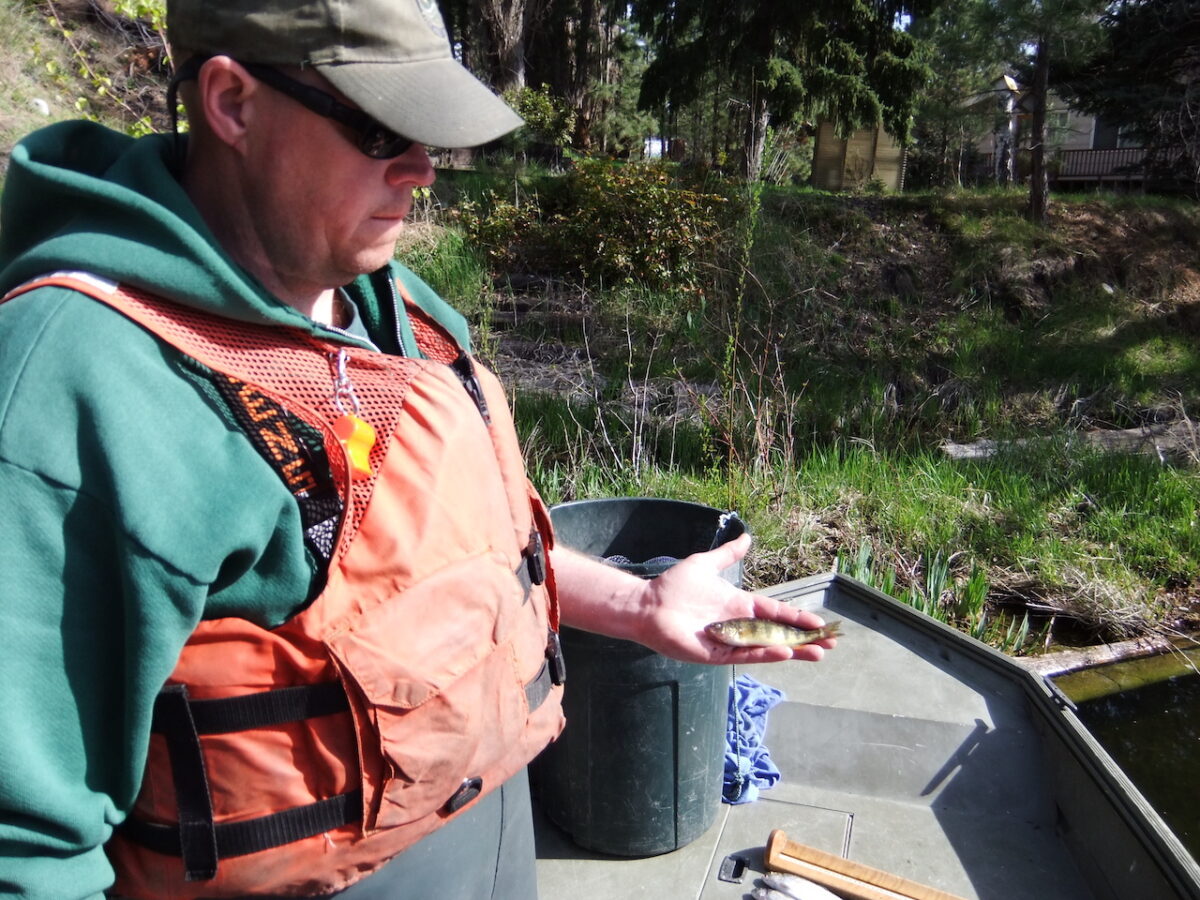
But since then I’ve heard WDFW soften its tone as Curlew’s perch population and fishery has inexorably taken off, as chronicled in a number of Tyler Hicks’ excellent YouTube videos. State managers have begun actively pimping the ice fishing and summer action here, and, what’s more, that hold-your-nose-and-roll-with-it-instead tack has generally avoided the pricey pitfalls that have come with battling other illegal perch introductions.
I recall writing a series of articles over a decade ago about a similar case of bucket biology that turned Eastern Oregon’s 2,235-acre Phillips Reservoir from that region’s “most popular trout fishery,” generating nearly $1.5 million in annual economic activity for Baker County, per ODFW, into one that saw over 1 million stunted perch gillnetted out of the lake over four springs at a cost of $40,000 to $50,000 before state managers pulled the plug on the effort and took the rare step (for them, anyway) of turning to tiger musky – a toothsome hybrid unable to reproduce but with a hearty appetite nonetheless – to help control them, as well as reduced and changed their trout release strategies.
TYPICALLY, EAST OF THE MOUNTAINS trout are released as fry to grow big in the relatively rich waters, saving money on hatchery feed and freeing up space at the facilities for other needs. But young perch not only outcompete the pint-sized rainbows for the same forage, but also the same space in the lake.
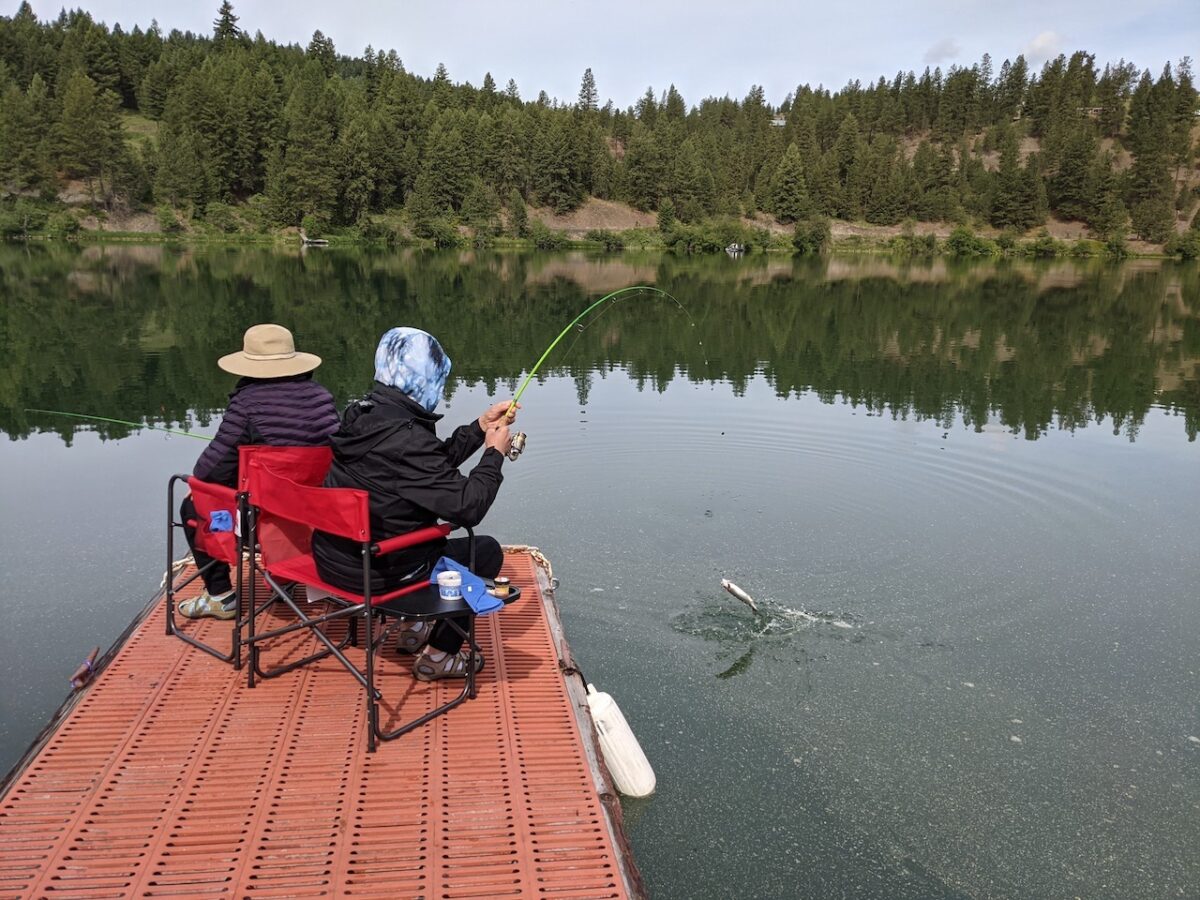
And readily able to spawn sans state help, perch soon swamp systems without a natural predator besides anglers to control their numbers. Given Curlew’s size and the fact it drains to the Kettle River, home to wild native redband rainbows, rotenoning the lake like WDFW does with smaller waters to clear them of unwanted invasives was a no go.
“As predicted, while the perch population rapidly expanded, the trout population (and fishery) suffered,” states Baker about Curlew. “Trout growth and condition declined, and as a result, so did the desire of anglers to keep the trout they caught. That is also reflected in the creel results.”
He says that even before the survey pointed it out, it had become “increasingly apparent” that rainbow releases had to be decreased, based on the growth rate, body condition and survival of stocked fish. Prior to the perch expansion, Baker says he would’ve expected 20 to 25 percent of the put-and-grow trout reared in netpens at the lake as well as 10 to 15 percent of the fingerlings put in in fall to survive and be caught, or 14 to 19 percent of the overall stocking total – basically, three to four times the survey’s observed 5.1 percent.
“So the ‘very low’ return to creel documented in the creel report is relative, but what is clear is that over the last few years, we’ve been stocking a lot of trout into Curlew Lake and the vast majority (95 percent) are not returning to creel,” Baker says. “In its heyday, Curlew Lake produced a lot of limits of beautiful 13- to 15-inch trout, and it wasn’t uncommon to catch some fish in the 17- to 20-inch range. From a trout fishing perspective, it’s a shadow of its former self … Bucket biology has a price, and it’s wise to recognize it.”
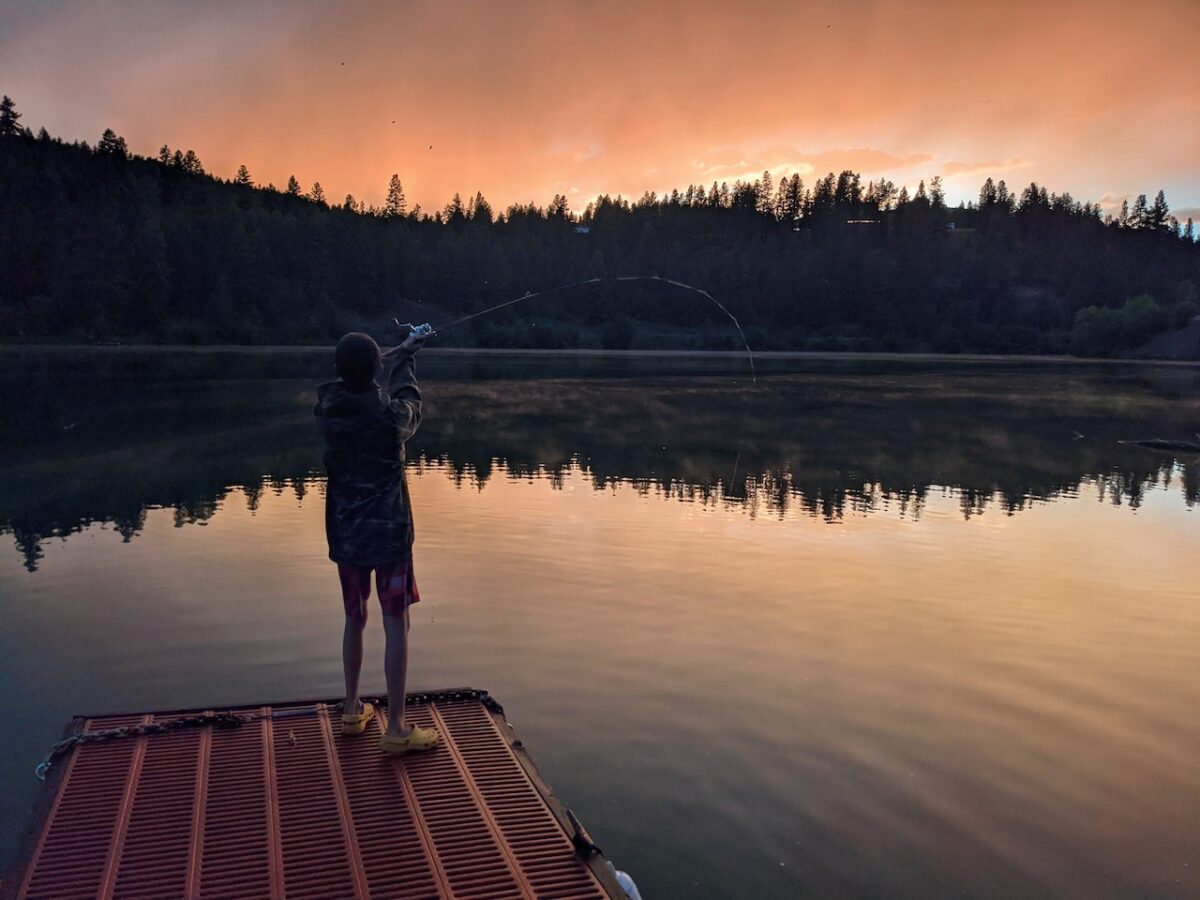
WDFW had been stocking from 225,000 to 235,000 fingerlings and put-and-grow trout annually up to 2010, then began reducing that as the perch population took off – from 205,000 to 210,000 in 2013 and 2014 to 185,000 each year through 2021.
Now comes an even deeper cut.
“To be clear, WDFW intends to maintain a trout fishery at Curlew Lake,” Baker reassures, “but we’ll be doing so while managing that fishery in concert with a robust yellow perch population, which is here to stay. In practice, that will mean dialing back the number of trout planted into the lake considerably and relying primarily on those 80,000 trout reared in the cooperative netpens to carry the fishery. The reduction in stocking, which was implemented beginning this fall, should allow for sufficient trout growth to produce quality fish – something worth taking home and putting on the dinner table.”

(In 2016, WDFW also began stocking kokanee at Curlew, with an initial release of 50,000 fry, which grew to 67,000 a couple years later, then dropped to the low to mid-20,000s for several years, 4,500 last year and none this year, per the statewide plan.)
A side benefit, he notes, is that this will allow the agency to reallocate hatchery production to “other waters to produce the best possible trout fisheries.”
AGAIN, BAKER ACKNOWLEDGES THAT Curlew’s fame was built on the back of ‘bows, but, as he says, there’s “no sense in trying to pound a square peg in a round hole” anymore.
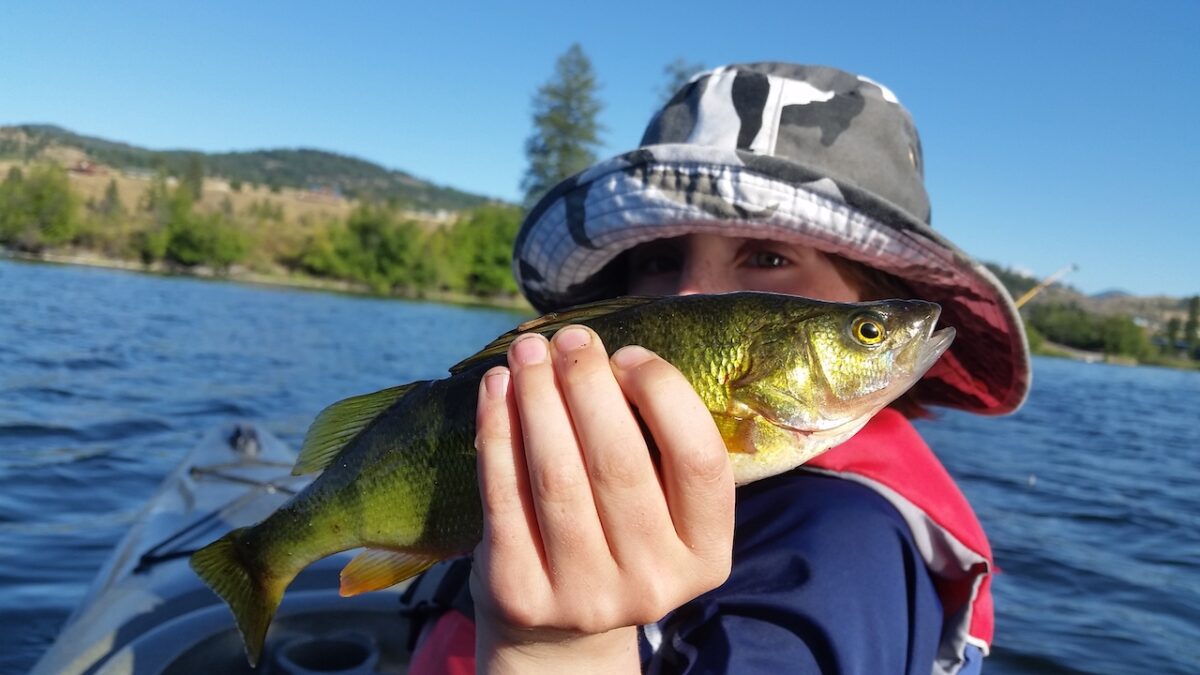
“I have met many anglers over the years who have been coming to Curlew Lake to fish for trout for their entire lives,” he says. “But the illegal introduction of yellow perch, first discovered in 2011, changed the dynamics of the fish community.”
And – who knows? – those new dynamics may be yielding the next gold rush in these here parts.
“We have been fortunate that, to date, perch growth rates have been sufficient to maintain high-quality size structure in the population, thus consistently producing large numbers of desirable-sized fish for anglers,” says Baker. “When perch are introduced, that’s not always the case. In fact, in my experience, it’s rarely the case. So, while it’s not what WDFW would have chosen, there is a lot of silver lining here.”
Time will tell if it’s only fool’s gold.
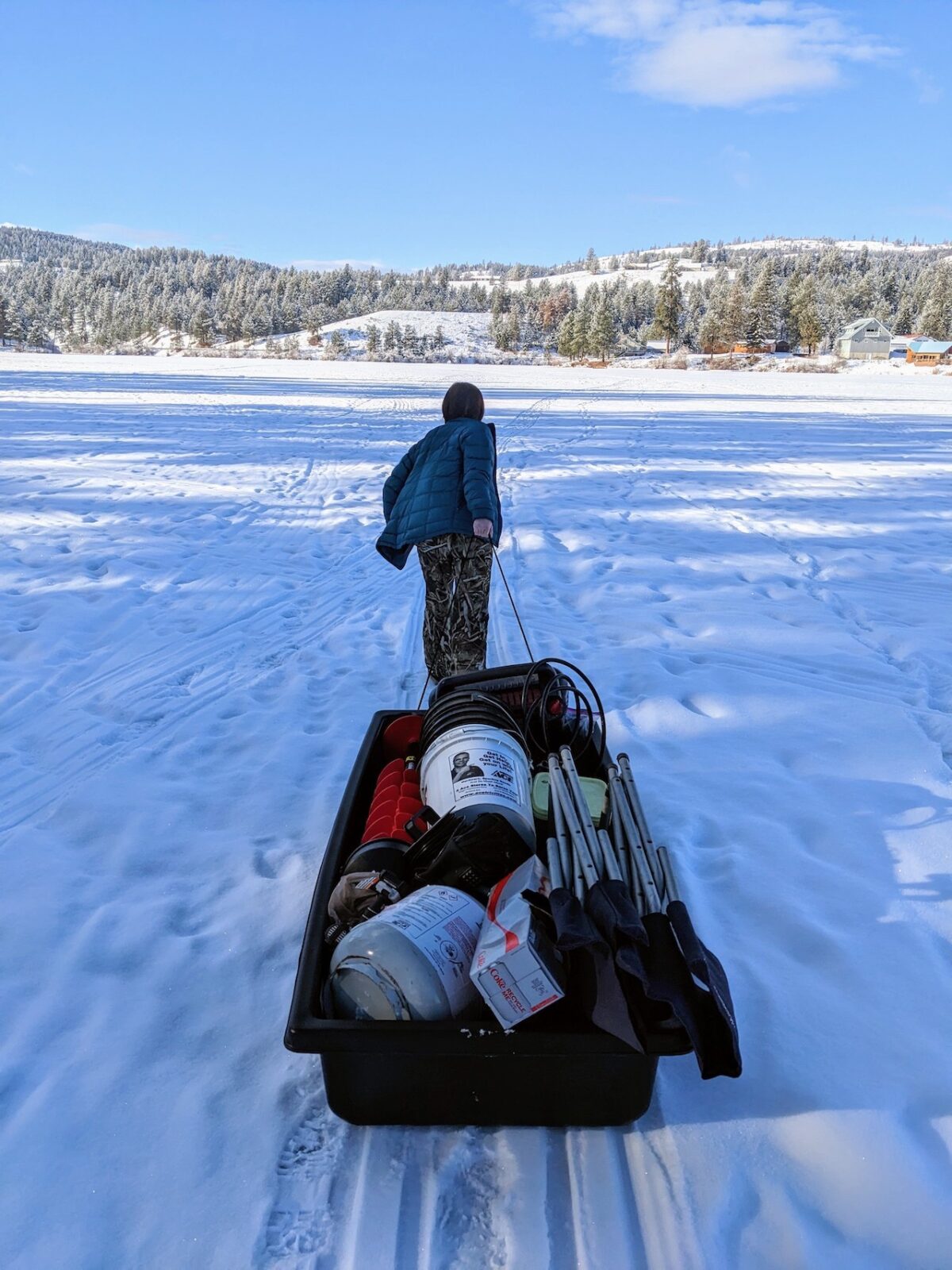
WDFW’S NINE-MONTH CREEL SURVEY estimated that the number of 8-plus-inch yellowbellies in the lake was 154,345 and, based on the number of specially tagged fish reported caught by anglers, 53 percent of the population was harvested. The largest catches and angler effort occurred in June 2021 and January 2022, when an estimated 12,000 and 14,000 perch were harvested, respectively, but they bit in all months. (November 2021 wasn’t surveyed and had minimal angling activity due to weather and unsafe ice conditions.) Boat fishing effort peaked in July.
Combining all of Curlew’s fisheries, there was 40,682 hours of total angling effort over the sampling period, 60 percent of which occurred from May through August, 28 percent from December through February and 12 percent in September and October, according to WDFW.
In a very rural region known for its achingly beautiful countryside and wide variety of family activities – as the Walgamotts discovered on a weeklong 2019 stay at the lake’s state park and which is cemented in our top 5 Northwest campouts of all time – angling at Curlew is an economic anchor and generates an estimated $546,335 in annual economic activity, the survey reported.
“Curlew Lake is still a great fishery, and a lot of the folks that have fished there for years for trout have now adapted to take advantage of the perch fishing,” says Baker. “Lots of other anglers who never fished it before have now discovered it. There’s reason to mourn the passing of a great trout fishery – or maybe it’s more accurate to say that the trout fishery will transition to something that’s still pretty good, but not great. But there’s also reason to celebrate what we have. Curlew Lake is arguably the best perch fishery in the state. There’s a lot of upside here.”

BUT BEFORE ANY ASSHATS GET ANY bright ideas about trying this move on a lake near them, the odds of an illicit release actually improving on state management are vanishingly slim, a Montana biologist’s database of 600-plus introductions shows, and anyway it remains illegal to move live fish between Washington waters, a crime punishable under RCW 77.15.290. The science of tracking where fish originally came from and when they were moved is growing, thanks to chemical signatures in the fish that act as telltale markers.
And while prosecutions may be few and far between, bucket biologists not only wreak environmental havoc impacting other fisheries and native organisms, they can create unexpected blowback that affects innocent bystanders’ fisheries. Following the illicit releases of walleye and northern pike in bass- and panfish-rich Lakes Washington and Sammamish, tribal comanagers have gone in with their gillnets and WDFW is working the ship canal with theirs, albeit to improve salmon smolt survival, but one wonders if it all would have occurred without those catalysts.
I get it, people are always going to thumb their noses at the Powers That Be, but I sense a building willingness across the region to battle back in a bare-knuckled way against the expansion of nonnative species, from smallmouth in Oregon’s Coquille River to pike in the Upper Columbia to walleye in the middle Snake and walleye and lake trout in North Idaho to perch and rock bass in Lake Washington. There’s been very, very early rumblings of a walleye bounty in the Snake, and in the Columbia, recent findings around the pikeminnow program could theoretically have overseers looking for a new target or targets to reduce salmon and steelhead losses.
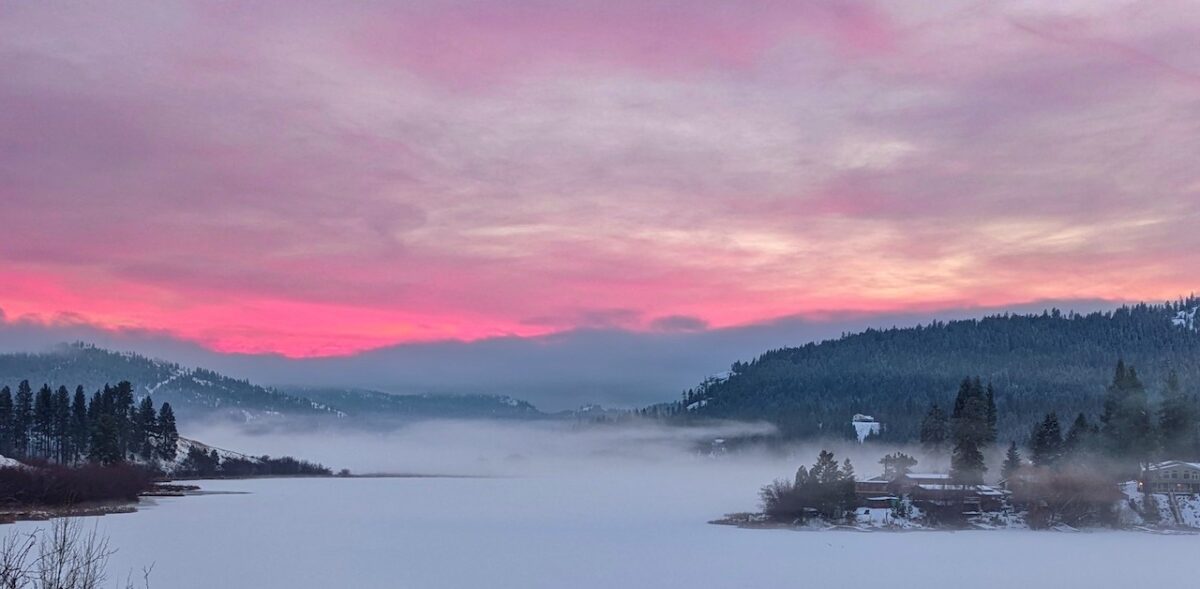
Maybe my tinfoil hat’s on a little too tight here this Friday afternoon, but I think my drift comes through.
Ahem, back to the subject at hand.
Another silver lining with Curlew’s new perch-friendly management strategy might be how big its rainbows get with fewer being released.
“It’s been a long internal discussion on best approaches to embrace what we currently have and maintain what we would prefer to have. Reducing trout stocking is likely our best approach,” states Region 1 Fish Program Manager Chris Donley in Spokane. “In the future, anglers should expect fewer but much larger quality trout. It will never be the same consistent quality trout fishery we saw 10-plus years ago, but it should be good, and seasonally – spring and fall – it could be really good. That said, other facets of the fishery like perch and largemouth bass will continue to provide additional opportunity.”
“In this case, we may be able to make at least a faux silk purse out of a sow’s ear,” Donley adds.

